
Mortellaro's Nursery
Shrubs, trees, ground covers, native plants, and seasonal color
Wholesale Only
Click on any of the alpha indexes below to view the corresponding lists of plants.
The default list is displayed alphabetically by common name for all plant types. You can view the plants by clicking on the Scientific Name or limit the plant type by using the drop down.
Plants actively being grown for the current season are shown -- selecting Discontinued Items will show plants we have offered in the past.
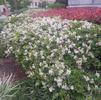
|
Hawthorn, Snow WhiteBotanical Name: Raphiolepis indica 'Snow White'
The Snow White Indian Hawthorn is a popular choice for Texas landscapes, valued for its attractive appearance and low-maintenance care requirements. This evergreen shrub typically grows to a height and spread of 4–5 feet, with a rounded form and glossy green leaves. Its standout feature is the profusion of white, lightly fragrant blooms in the spring, followed by small, bluish-black berries that attract birds. With its compact growth habit and year-round foliage, it works well for borders, foundation plantings, or low hedges. Snow White is drought-tolerant once established but performs best with moderate watering, particularly during prolonged periods of heat and drought common in Texas summers. It thrives in full sun to partial shade and prefers well-drained soils. While Snow White adapts to a range of soil pH levels, it does slightly better in acidic to neutral soils. A key consideration when planting is its susceptibility to leaf spot, especially in areas with poor air circulation or excessive shade. Ensuring the plant is placed in a sunny location with good ventilation helps minimize this issue and promotes healthier growth. Mulching around the base of the plant also retains moisture and keeps roots cool during the heat. Deer tend to find Indian Hawthorn appealing and may graze on it, particularly in areas with high deer populations and limited food sources. Gardeners in deer-prone regions of Texas might need to use deterrents or plant Snow White in protected areas. Despite challenges like leaf spot and deer browsing, the shrub’s resilience, attractive blooms, and ease of care make it a valuable addition to any Texas landscape, especially when paired with other drought-resistant and deer-tolerant plants. [ More Info ]
|

|
Hibiscus, OrangeBotanical Name: Hibiscus rosa-sinensis
[ More Info ]
|

|
Hibiscus, RedBotanical Name: Hibiscus rosa-sinensis
[ More Info ]
|

|
Hibiscus, YellowBotanical Name: Hibiscus rosa-sinensis
[ More Info ]
|
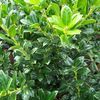
|
Holly, Burford DwarfBotanical Name: Ilex cornuta 'Burfordii Nana'
The Dwarf Burford Holly is a compact evergreen shrub commonly used in landscapes as a foundation planting, border, or hedge. This cultivar typically grows to a mature height of 3 to 4 feet with a spread of 4 to 5 feet, allowing it to be utilized in smaller areas. Dwarf Burford Holly is hardy for many areas in Texas, though it may not do as well in areas with extreme drought or poorly draining soils. Its glossy, dark green leaves provide year-round interest, and in late fall to early winter, it produces bright red berries that persist through the colder months. The berries attract birds and provide seasonal color, making it a popular choice for wildlife-friendly gardens. Dwarf Burford Holly is also known for being deer-resistant, and low maintenance. It prefers slightly acidic soils and does best with consistent moisture, although it can tolerate brief periods of drought once established. It thrives in well-drained soil, but tolerates some poor drainage in areas with clay soils. When planting multiple Dwarf Burford Hollies, space them about 3 to 4 feet apart to allow for their mature spread. It will grow in full sun to partially shaded areas. In winter, Dwarf Burford Holly can tolerate freezing temperatures, but it will benefit from mulching around the base to protect the roots from freezing temperatures. Pruning can be done in early spring to maintain a neat appearance, as the shrub tends to grow densely. [ More Info ]
|
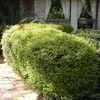
|
Holly, Dwarf YauponBotanical Name: Ilex vomitoria 'Nana'
Dwarf Yaupon Holly, is a Texas-native versatile and low-maintenance evergreen shrub ideal for Texas landscapes. This compact, slow-growing plant typically reaches 2-4 feet in height and width, making it an excellent choice for borders, hedges, or mass plantings. Its small, rounded leaves provide a fine texture and tidy appearance year-round. Highly adaptable, it performs well in both acidic and alkaline soils, provided they are well-draining. Dwarf Yaupon Holly thrives in Texas' challenging climate, tolerating both intense heat and freezing temperatures. Its drought-resistant nature makes it ideal for xeriscaping, while its ability to handle periodic wet conditions adds to its versatility. Additionally, this plant is highly deer-resistant, making it a reliable choice in areas where browsing is a concern. It can be planted in full sun or partial shade. Though slow-growing, the long-term benefits of Dwarf Yaupon Holly are worth the wait. Its dense growth habit and minimal pruning requirements make it a popular choice for low-maintenance landscaping. The plant can also be used to create a formal look when shaped into hedges or left natural for a softer, more informal effect. Ilex vomitoria received its name from its usage with Native Americans; it was an ingredient in teas used in rituals that would induce vomiting. Yaupon tolerates nearly any quality type of soil, and can be grown along the coastline as well. [ More Info ]
|
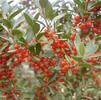
|
Holly, Native YauponBotanical Name: Ilex vomitoria
Native to Texas, Yaupon Holly is a species of holly that tolerates the hot and dry Texas summers with relative ease, however prospers when provided more ideal conditions. Yaupons include evergreen shrubs or small trees with light gray bark, and small oval shaped alternate leaves with coarsely serrated margins. It forms multiple stems in clumps, giving the plant some density despite the smaller leaves. The small white flowers in the spring are somewhat striking; however the red drupe berries that follow in the fall to winter are the main attraction. They stay on during the winter, attracting birds and other wildlife as a food source. Ilex vomitoria received its name from its usage with Native Americans; it was an ingredient in teas used in rituals that would induce vomiting. Yaupon tolerates nearly any quality type of soil, and can be grown along the coastline as well. [ More Info ]
|
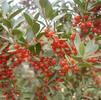
|
Holly, Native Yaupon (Pyramid)Botanical Name: Ilex vomitoria
Native to Texas, Yaupon Holly is a species of holly that tolerates the hot and dry Texas summers with relative ease, however prospers when provided more ideal conditions. Yaupons include evergreen shrubs or small trees with light gray bark, and small oval shaped alternate leaves with coarsely serrated margins. It forms multiple stems in clumps, giving the plant some density despite the smaller leaves. The small white flowers in the spring are somewhat striking; however the red drupe berries that follow in the fall to winter are the main attraction. They stay on during the winter, attracting birds and other wildlife as a food source. Ilex vomitoria received its name from its usage with Native Americans; it was an ingredient in teas used in rituals that would induce vomiting. Yaupon tolerates nearly any quality type of soil, and can be grown along the coastline as well. [ More Info ]
|
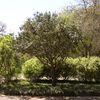
|
Holly, Nellie R. StevensBotanical Name: Ilex x 'Nellie R. Stevens'
Nellie R. Stevens holly stands out as a popular choice for landscapes in the state of Texas, offering a unique blend of beauty, resilience, and functionality. This evergreen shrub boasts glossy, dark green leaves and vibrant red berries, adding year-round interest to gardens and urban settings. Its dense growth habit and tolerance to a variety of environmental conditions make it a versatile and reliable option for Texas landscapes. One of the primary uses of Nellie R. Stevens holly in Texas is as a hedging plant or privacy screen. Its dense foliage and fast growth rate make it well-suited for creating visual barriers and defining property lines. Whether used as a standalone hedge or incorporated into mixed borders, this holly cultivar provides both aesthetic appeal and functional benefits, such as noise reduction and windbreak. Furthermore, Nellie R. Stevens holly is valued for its ability to thrive in the challenging climate of Texas, including heat, drought, and slightly alkaline soils, although it appreciates acidic soils more. Its adaptability to a range of soil types and its low maintenance requirements make it a popular choice for homeowners and landscapers seeking resilient plants that can withstand the rigors of Texas summers. Too much alkaline will turn leaves yellow, however regular fertilization and soil treatments will turn foliage back to green. [ More Info ]
|
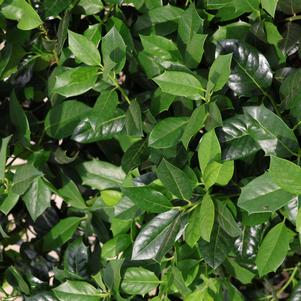
|
Holly, Nellie R. Stevens "Standard Form"Botanical Name: Ilex x 'Nellie R. Stevens'
Nellie R. Stevens holly stands out as a popular choice for landscapes in the state of Texas, offering a unique blend of beauty, resilience, and functionality. This evergreen shrub boasts glossy, dark green leaves and vibrant red berries, adding year-round interest to gardens and urban settings. Its dense growth habit and tolerance to a variety of environmental conditions make it a versatile and reliable option for Texas landscapes. One of the primary uses of Nellie R. Stevens holly in Texas is as a hedging plant or privacy screen. Its dense foliage and fast growth rate make it well-suited for creating visual barriers and defining property lines. Whether used as a standalone hedge or incorporated into mixed borders, this holly cultivar provides both aesthetic appeal and functional benefits, such as noise reduction and windbreak. Furthermore, Nellie R. Stevens holly is valued for its ability to thrive in the challenging climate of Texas, including heat, drought, and slightly alkaline soils, although it appreciates acidic soils more. Its adaptability to a range of soil types and its low maintenance requirements make it a popular choice for homeowners and landscapers seeking resilient plants that can withstand the rigors of Texas summers. Too much alkaline will turn leaves yellow, however regular fertilization and soil treatments will turn foliage back to green. [ More Info ]
|

|
Holly, Nellie R. Stevens "Tree Form"Botanical Name: Ilex x 'Nellie R. Stevens'
Nellie R. Stevens holly stands out as a popular choice for landscapes in the state of Texas, offering a unique blend of beauty, resilience, and functionality. This evergreen shrub boasts glossy, dark green leaves and vibrant red berries, adding year-round interest to gardens and urban settings. Its dense growth habit and tolerance to a variety of environmental conditions make it a versatile and reliable option for Texas landscapes. One of the primary uses of Nellie R. Stevens holly in Texas is as a hedging plant or privacy screen. Its dense foliage and fast growth rate make it well-suited for creating visual barriers and defining property lines. Whether used as a standalone hedge or incorporated into mixed borders, this holly cultivar provides both aesthetic appeal and functional benefits, such as noise reduction and windbreak. Furthermore, Nellie R. Stevens holly is valued for its ability to thrive in the challenging climate of Texas, including heat, drought, and slightly alkaline soils, although it appreciates acidic soils more. Its adaptability to a range of soil types and its low maintenance requirements make it a popular choice for homeowners and landscapers seeking resilient plants that can withstand the rigors of Texas summers. Too much alkaline will turn leaves yellow, however regular fertilization and soil treatments will turn foliage back to green. [ More Info ]
|
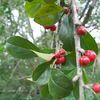
|
Holly, Possumhaw YauponBotanical Name: Ilex decidua 'Warren's Red'
Possumhaw ‘Warren’s Red’ is a selected female cultivar of the Texas native Ilex decidua, prized for its deep red berries that persist through winter. Unlike the species, which is typically grown from seed and produces both male and female plants, ‘Warren’s Red’ is exclusively propagated by stem cuttings to ensure its berry-producing traits. This process is challenging, with a failure rate of 25 to 40%, making the plant more difficult to produce in quantity. However, its striking winter display makes it highly sought after for landscapes. Like the standard Possumhaw, ‘Warren’s Red’ thrives in a variety of soil types, including clay, loam, and sandy soils, as long as they are well-draining. It is highly adaptable to Texas landscapes, tolerating both periodic drought and seasonal flooding, making it a great choice for areas with fluctuating moisture levels. It grows well in full sun to partial shade, but the best berry production occurs in locations with ample sunlight. This cultivar is deer-resistant and non-toxic, making it a safe and reliable choice for residential landscapes. At maturity, ‘Warren’s Red’ reaches a height of 15 to 20 feet with a spread of 10 to 15 feet. It is commonly used as a specimen tree or in naturalized groupings, where its bright berries create a striking contrast against its bare winter branches. When planting multiple specimens, spacing of at least 10 to 15 feet is recommended to allow for proper growth. Since this cultivar is female, a male Ilex decidua must be nearby for optimal fruit production. This deciduous holly loses its leaves in winter, but the dense berry clusters provide seasonal interest long after the foliage has dropped. In cold regions, occasional branch dieback may occur, but the plant is hardy and typically rebounds in the spring. If shaping or pruning is necessary, it is best done in late winter before new growth emerges.
[ More Info ]
|

|
Holly, Possumhaw Yaupon (Native)Botanical Name: Ilex decidua
Possumhaw is a Texas native deciduous holly known for its striking winter display of bright red berries. This small tree or large shrub is a valuable addition to the landscape, providing year-round interest with its dense green foliage in the growing season and showy fruit in the colder months. Thriving in a wide range of soil conditions, including acidic or alkaline soils, it is well-suited to Texas landscapes. Possumhaw is adaptable to various moisture levels, tolerating both seasonal flooding and periods of drought, making it a resilient choice for naturalistic plantings. This holly is dioecious, meaning individual plants are either male or female. Only female plants produce the vibrant berries, but a male plant must be present nearby for pollination. When grown from seed, the sex of the plant is unpredictable, so purchasing a large specimen that has been identified as a female or one showing berries may be preferable for those seeking reliable berry production. The berries provide an important winter food source for birds, adding ecological value to the landscape. Possumhaw is also deer-resistant and tolerates full sun to partial shade, although berry production is best with ample sunlight. Mature Possumhaw trees reach heights of 15 to 25 feet with a spread of 10 to 15 feet. When used for screening or mass planting, space them about 8 to 12 feet apart. The tree’s naturally multi-trunked habit can be maintained for a shrubby form, or it can be trained into a single trunk for a more tree-like appearance. It is commonly used as a specimen plant, in mixed woodland borders, or as part of a wildlife-friendly habitat. Though Possumhaw is highly cold-hardy and well-adapted to Texas winters, its berries persist longest in milder climates where birds do not consume them quickly. No special winter protection is needed, as the tree naturally sheds its leaves in fall, leaving behind its signature display of fruit. Pruning can be done in late winter before new growth begins, shaping the plant as desired while preserving berry production for the following season. [ More Info ]
|
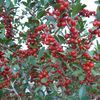
|
Holly, Pride of Houston YauponBotanical Name: Ilex vomitoria 'Pride of Houston'
‘Pride of Houston’ Yaupon Holly is a superior selection of the Texas native Yaupon Holly, chosen for its uniform growth habit and abundant berry production. This female-only cultivar is propagated through stem cuttings, as it does not grow true from seed. However, even with vegetative propagation, success rates can vary, making high-quality specimens sought after. Its dense, upright form and ability to thrive in a range of conditions make it a reliable choice for landscapes across Texas. It typically grows 15 to 20 feet tall and 8 to 12 feet wide. When planting together, space them 6 to 10 feet apart. One of the standout qualities of ‘Pride of Houston’ is its extreme tolerance to both heat and cold. It performed exceptionally well during Texas’s historic freeze, proving its resilience in temperatures that devastated many other evergreen shrubs. Equally, it withstands the intense summer heat, thriving in full sun with little maintenance. This adaptability makes it an excellent choice for urban and rural landscapes alike, whether used as a hedge, screen, or specimen tree. It is also highly drought-tolerant once established and resistant to pests and diseases. Like all Yaupon Hollies, ‘Pride of Houston’ thrives in both acidic and alkaline soils and tolerates poor drainage better than most hollies, making it suitable for areas with periodic wet conditions. Its small evergreen leaves provide year-round structure, and female plants produce striking red berries in the fall and winter, attracting birds and adding seasonal interest. Deer typically avoid Yaupon Holly, adding to its reliability in Texas landscapes. For best results, plant ‘Pride of Houston’ Yaupon Holly in well-draining soil and provide occasional deep watering during extended droughts. If shaping is desired, light pruning can be done in late winter. This cultivar is an excellent long-term investment for Texas landscapes, offering year-round appeal with minimal care. [ More Info ]
|
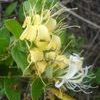
|
Honeysuckle, HallsBotanical Name: Lonicera japonica 'Halliana'
A vigorous semi-evergreen that is not only used as a vine or groundcover, but can be trimmed into a hedge. It should be segregated from other shrubs or small trees as it can rapidly cover them.
Hall's Honesuckle grows up to 15 feet in length and bears fragrant yellow-white flowers throughout the warm seasons, attracting butterflies. It will grow in the shade, but will not flower.
Tolerant of poor soils and drought, coupled with rapid growth habit make this honeysuckle an ideal choice for mass plantings on banks and slopes for controlling erosion. In the landscape, it tolerates heavy pruning (even mowing) in the fall to keep under control.
[ More Info ]
|
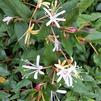
|
Honeysuckle, PurpleBotanical Name: Lonicera japonica 'Purpurea'
A vigorous semi-evergreen that is used as a vine or groundcover. It should be segregated from other shrubs or small trees as it can rapidly cover them.
'Purpureae' grows up to 15 feet in length and bears fragrant purplish-red and white flowers throughout the warm seasons, attracting butterflies. It will grow in the shade, but will not flower. The leaves are a dark green to purple-green on top, with a purple hue underneath.
Tolerant of poor soils and drought, coupled with rapid growth habit make this honeysuckle an ideal choice for mass plantings on banks and slopes for controlling erosion. In the landscape, it tolerates heavy pruning (even mowing) in the fall to keep under control.
[ More Info ]
|
